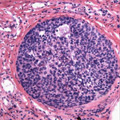This page has been archived and is no longer updated

Cancer is caused, at least in part, by aberrant cell division. Cells begin to divide when they normally would not (and they survive when they normally should not). What processes are involved in normal cell division and what does this knowledge tell us about cancer?
Mitosis, Meiosis, and Inheritance
Although mitosis and meiosis both involve cell division, they transmit genetic material in very different ways. What happens when either of these processes goes awry?
The five phases of mitosis and cell division tightly coordinate the movements of hundreds of proteins. How did early biologists unravel this complex dance of chromosomes?
L. H. Hartwell's Yeast: A Model Organism for Studying Somatic Mutations and Cancer
Think yeast just belongs in the kitchen? Mitosis in baker's yeast can also tell us about mutations that cause cancer.
Mutations in proto-oncogenes and tumor suppressor genes are resposible for aberrant cell division and survival. What are some of these genes? How were they discovered?
In cancer, one of the leading causes of death in the US, cells divide wildly out of control. Can tumor suppressor genes and proto-oncogenes provide clues on how to stop this process?
Proto-oncogenes to Oncogenes to Cancer
What drives cancer cells to grow and divide uncontrollably turning into cancer? Studies of proto-oncogenes reveal some clues about how normal cellular processes mutate and go awry.
Tumor Suppressor (TS) Genes and the Two-Hit Hypothesis
Tumor suppressor genes act as “brakes” to stop cells before they can travel down the road to cancer. A loss of function mutation in these genes can be disastrous.
What can we learn about cancer from the study of chromosomes? How can translocations teach us about oncogenes?
Chromosome Abnormalities and Cancer Cytogenetics
Thousands of chromosomal aberrations have been discovered in different types of cancer. But how do these various changes all hijack normal cellular processes to promote cancer?
Human Chromosome Translocations and Cancer
Translocations generate novel chromosomes, but are often linked to disorders like infertility and cancer. How do these new chromosomes generate problems, and how are they detected?
Gleevec: the Breakthrough in Cancer Treatment
How do scientists develop new treatments for disease? With Gleevec, a remarkable cancer drug, the approach was to target the disease at the cellular and subcellular level.
Cancer is a group of complex disorders resulting from mutations at multiple genetic loci and the environment. How are scientists identifying the genetic lesions that contribute to tumorigenesis?
Functions and Utility of Alu Jumping Genes
Alu elements have long been considered "junk" DNA--or, even worse, "selfish" DNA. Turns out, these prolific transposons are much more useful than originally thought.
Genes, Smoking, and Lung Cancer
Imagine reading this warning on a cigarette package: Smokers with a particular mutation have a dramatically higher risk of developing lung cancer. Would you get tested for this mutation?